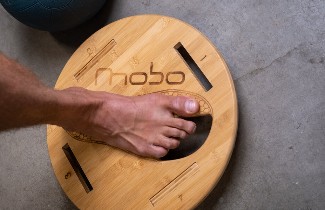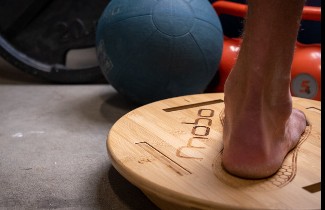





Jay Dicharry, MPT, SCS
Originally from New Orleans LA, Jay completed the Masters of Physical Therapy degree at Louisiana State University Medical Center and is a Board- Certified Sports Clinical Specialist. Jay built his international reputation as an expert in biomechanical analysis as Director of the SPEED Clinic at the University of Virginia. Through this innovative venture, Jay was able to blend the fields of clinical practice and engineering to better understand and eliminate the cause of overuse injuries in endurance athletes. His unique approach goes outside the traditional model of therapy and aims to correct imbalances before they affect your performance.
Jay literally wrote the book on running gait assessments: he is author of “Running Rewired” + “Anatomy for Runners“, writes columns for numerous magazines, and has published over 35 professional journal articles and book chapters. Jay has had an active research career, teaches nationally, and consults for numerous footwear companies, the US Air Force and USA Track and Field. His ongoing research focus on footwear and the causative factors driving overuse injury continues to provide him cutting edge knowledge to educate and provide patients with an unmatched level of innovation and success. Having taught in the Sports Medicine program at UVA and Oregon State University-Cascades, he brings a strong bias towards patient education, and continues to teach nationally to elevate the standard of care for Therapists, Physicians, and Coaches working with endurance athletes.
In addition to his clinical distinction, Jay is a certified coach through both the United States Track and Field Association and the United States Cycling Federation, and certified Golf Fitness Instructor through Titleist Performance Institute. He has a competitive history in swimming, triathlon, cycling, and running events on both the local and national level, and has coached athletes from local standouts to national medalists. He enjoys exploring the Pacific Northwest with his family on knobbies, skis, boards, and soles.
$0
I am currently not taking any new patients. Please feel free to check out my other resources
BOOK NOW
If you have been dealing with aches and pains on the inside of your sh...Read More
If you have been dealing with aches and pains on the inside of your shin, it’s time to stop chasing your symptoms and fix the cause. “Shin splints” is the lay term used to describe what we in the medical community call “posterior tibial stress syndrome.” Let’s decode this term.
Muscles work by pulling two parts together. One lever is connected to another lever at a pivot point. During a bicep curl, your bicep contracts concentrically to pull your forearm up to your shoulder. A concentric contraction means the working muscle is shortening. When muscles work eccentrically, they move the levers by lengthening. An example of this is the “negative” phase of a lift, like when you lower the weight very slowly in that same bicep curl. Your bicep is working hard to lower the weight in a controlled manner. Eccentric control is actually very stressful to muscles. If you are like most runners, you might not be interested in bulking up your biceps, but you need to understand eccentric muscle contraction to solve your shin splint problem.
When the foot makes contact with the ground, it’s the job of the tibialis posterior muscle to work eccentrically to slow the foot as it twists down to the ground (pronation). In the case of the bicep curl, it’s easy to see how your rigid upper arm and your rigid forearm pivot on each other at your elbow. But the foot and ankle are more complex levers. The tibialis posterior attaches to your rigid shin (tibia) on one side, but on the other side there is not just one bone, but 26 individual bones that make up your foot. If that set of bones is well controlled, the tibialis posterior can work eccentrically to smoothly lower your foot to the ground. But if you show up with poor foot coordination and control, one end of the lever (your foot) is very unstable and likely to collapse. This compromises the tibialis posterior and its tendon. Muscles and tendons don’t like to be in lengthened positions where they are under more strain, become weaker, and can’t generate the eccentric control to guide your foot safely down to the floor. So your shin hurts.
What’s the Fix?
In this all-too-common scenario, the posterior tibialis is the victim, not the cause of the problem. It’s being asked to do more than it can handle, and more than it ever should. The poorly controlled foot is to blame. That bag of bones needs to become a stable platform. Foot control is 100 percent dependent on your forefoot control, specifically the big toe. With a stable big toe, your forefoot is stabilized, which creates a stable platform for your rearfoot, which means your tibialis posterior can stop trying to do the work of other muscles. Simply put, if you want to unload the muscles in your shins, you need to improve the control and coordination in your feet. To learn more about this and other problems that plague runners, please check out our founder’s book Running Rewired. But if you want to start improving your foot control now, MOBO is the tool to bring your foot up to speed and build a strong and stable foot. Get yours, hit the exercises tab above, and get to work on a better you.
Check out more info on my websites https://anathletesbody.com/ and https://www.moboboard.com/

0

0

0
you must login

I know it can be a tough sell to tell athletes that they need to add y...Read More
I know it can be a tough sell to tell athletes that they need to add yet another exercise to their weekly training plan. But remember we aren’t training just the knee and above - we need to train the entire athlete —> and that includes the foot as well! But I get it, most athletes don’t get excited about just training to minimize injury, they want to see results. We believe in pushing the needle in every way possible. And do so with our athletes. And yes, we have clinical proof, outcomes proof, and yes research proof. Let’s summarize the references below: Attempts to strengthen the feet ARE successful, and more importantly that improving foot strength results in an INCREASE in performance.
So when you are talking to your athletes and patients: improving intrinsic foot control isn’t just “something else to do.” - its part of optimal preparation.
Want this said simply? Here’s a great summary statement from the Suloska paper referenced below: “Exercises strengthening short foot muscles may improve energy transfer through body segments and increase strength and values of generated power. They should be included as a part of daily training programme of runners.”
Leave no stone unturned. That’s our moto with our athletes. And while we hope you use MOBO as part of this journey with your patients and athletes, we really hope that whatever tools you use, you address the whole body for better outcomes!
Check out more info on my websites https://anathletesbody.com/ and https://www.moboboard.com/

0

0

0
you must login
Jay Dicharry, MPT, SCS
Originally from New Orleans LA, Jay completed the Masters of Physical Therapy degree at Louisiana State University Medical Center and is a Board- Certified Sports Clinical Specialist. Jay built his international reputation as an expert in biomechanical analysis as Director of the SPEED Clinic at the University of Virginia. Through this innovative venture, Jay was able to blend the fields of clinical practice and engineering to better understand and eliminate the cause of overuse injuries in endurance athletes. His unique approach goes outside the traditional model of therapy and aims to correct imbalances before they affect your performance.
Jay literally wrote the book on running gait assessments: he is author of “Running Rewired” + “Anatomy for Runners“, writes columns for numerous magazines, and has published over 35 professional journal articles and book chapters. Jay has had an active research career, teaches nationally, and consults for numerous footwear companies, the US Air Force and USA Track and Field. His ongoing research focus on footwear and the causative factors driving overuse injury continues to provide him cutting edge knowledge to educate and provide patients with an unmatched level of innovation and success. Having taught in the Sports Medicine program at UVA and Oregon State University-Cascades, he brings a strong bias towards patient education, and continues to teach nationally to elevate the standard of care for Therapists, Physicians, and Coaches working with endurance athletes.
In addition to his clinical distinction, Jay is a certified coach through both the United States Track and Field Association and the United States Cycling Federation, and certified Golf Fitness Instructor through Titleist Performance Institute. He has a competitive history in swimming, triathlon, cycling, and running events on both the local and national level, and has coached athletes from local standouts to national medalists. He enjoys exploring the Pacific Northwest with his family on knobbies, skis, boards, and soles.
Training Block was created with a mission to support and empower runners, in order to elevate our sport. We do so by giving runners access to a network of local sport performance providers, who provide runners with the care they need from coaching, physical therapy, massage, strength training, and more. We also give providers an easy way to connect with each other and share articles, videos, and other resources that benefit runners and providers alike. For every service booked through Training Block, we donate 10% of our revenues to Training Block’s Elite Athlete Fund, which sponsors elite runners who do not have professional contracts and need financial support for racing at their highest level.
Copyright © 2024 Training Block. All rights reserved.
Refer a friend and get $5 discount on order!